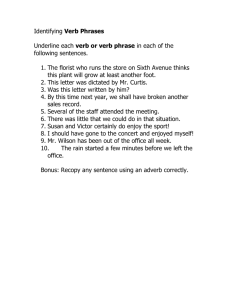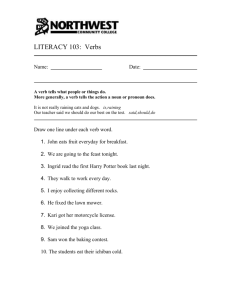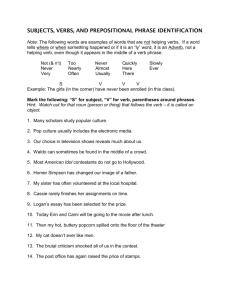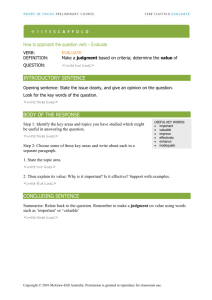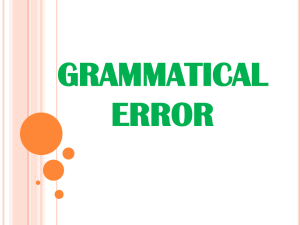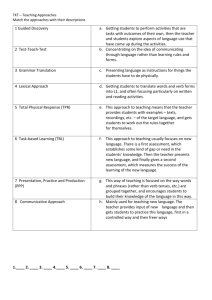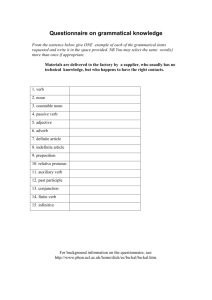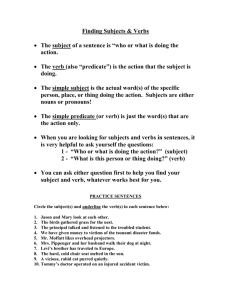Document 13199781
advertisement
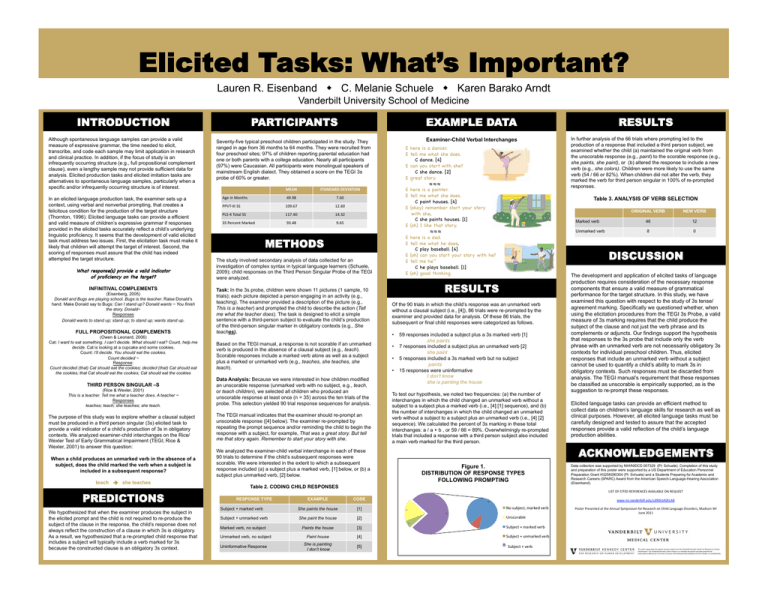
Elicited Tasks: What’s Important? Lauren R. Eisenband C. Melanie Schuele Karen Barako Arndt Vanderbilt University School of Medicine INTRODUCTION Although spontaneous language samples can provide a valid measure of expressive grammar, the time needed to elicit, transcribe, and code each sample may limit application in research and clinical practice. In addition, if the focus of study is an infrequently occurring structure (e.g., full propositional complement clause), even a lengthy sample may not provide sufficient data for analysis. Elicited production tasks and elicited imitation tasks are alternatives to spontaneous language samples, particularly when a specific and/or infrequently occurring structure is of interest. In an elicited language production task, the examiner sets up a context, using verbal and nonverbal prompting, that creates a felicitous condition for the production of the target structure (Thornton, 1996). Elicited language tasks can provide a efficient and valid measure of children’s expressive grammar if responses provided in the elicited tasks accurately reflect a child’s underlying linguistic proficiency. It seems that the development of valid elicited task must address two issues. First, the elicitation task must make it likely that children will attempt the target of interest. Second, the scoring of responses must assure that the child has indeed attempted the target structure. What response(s) provide a valid indicator of proficiency on the target? INFINITIVAL COMPLEMENTS (Eisenberg, 2005) Donald and Bugs are playing school. Bugs is the teacher. Raise Donald’s hand. Make Donald say to Bugs: Can I stand up? Donald wants ~ You finish the story. Donald~ Responses Donald wants to stand up; stand up; to stand up; wants stand up. FULL PROPOSITIONAL COMPLEMENTS (Owen & Leonard, 2006) Cat: I want to eat something. I can’t decide. What should I eat? Count, help me decide. Cat is looking at a cupcake and some cookies. Count: I’ll decide. You should eat the cookies. Count decided ~ Response: Count decided (that) Cat should eat the cookies; decided (that) Cat should eat the cookies; that Cat should eat the cookies; Cat should eat the cookies THIRD PERSON SINGULAR –S (Rice & Wexler, 2001) This is a teacher. Tell me what a teacher does. A teacher ~ Responses teaches; teach; she teaches; she teach. The purpose of this study was to explore whether a clausal subject must be produced in a third person singular (3s) elicited task to provide a valid indicator of a child’s production of 3s in obligatory contexts. We analyzed examiner-child interchanges on the Rice/ Wexler Test of Early Grammatical Impairment (TEGI; Rice & Wexler, 2001) to answer this question: When a child produces an unmarked verb in the absence of a subject, does the child marked the verb when a subject is included in a subsequent response? teach she teaches PREDICTIONS We hypothesized that when the examiner produces the subject in the elicited prompt and the child is not required to re-produce the subject of the clause in the response, the child’s response does not always reflect the construction of a clause in which 3s is obligatory. As a result, we hypothesized that a re-prompted child response that includes a subject will typically include a verb marked for 3s because the constructed clause is an obligatory 3s context. PARTICIPANTS Seventy-five typical preschool children participated in the study. They ranged in age from 36 months to 64 months. They were recruited from four preschool sites; 97% of children reporting parental education had one or both parents with a college education. Nearly all participants (97%) were Caucasian. All participants were monolingual speakers of mainstream English dialect. They obtained a score on the TEGI 3s probe of 60% or greater. Table 1. PARTICIPANT MEAN CHARACTERISTICS STANDARD DEVIATION Age in Months 49.98 7.60 PPVT-­‐III SS 109.67 12.60 PLS-­‐4 Total SS 117.40 14.32 3S Percent Marked 93.48 9.65 METHODS The study involved secondary analysis of data collected for an investigation of complex syntax in typical language learners (Schuele, 2009); child responses on the Third Person Singular Probe of the TEGI were analyzed. Task: In the 3s probe, children were shown 11 pictures (1 sample, 10 trials); each picture depicted a person engaging in an activity (e.g., teaching). The examiner provided a description of the picture (e.g., This is a teacher) and prompted the child to describe the action (Tell me what the teacher does). The task is designed to elicit a simple sentence with a third-person subject to evaluate the child’s production of the third-person singular marker in obligatory contexts (e.g., She teaches). Based on the TEGI manual, a response is not scorable if an unmarked verb is produced in the absence of a clausal subject (e.g., teach). Scorable responses include a marked verb alone as well as a subject plus a marked or unmarked verb (e.g., teaches, she teaches, she teach). Data Analysis: Because we were interested in how children modified an unscorable response (unmarked verb with no subject, e.g., teach, or teach children), we selected all children who produced an unscorable response at least once (n = 35) across the ten trials of the probe. This selection yielded 90 trial response sequences for analysis. The TEGI manual indicates that the examiner should re-prompt an unscorable response ([4] below). The examiner re-prompted by repeating the prompt sequence and/or reminding the child to begin the response with a subject, for example, That was a great story. But tell me that story again. Remember to start your story with she. EXAMPLE DATA RESULTS Examiner-Child Verbal Interchanges In further analysis of the 66 trials where prompting led to the production of a response that included a third person subject, we examined whether the child (a) maintained the original verb from the unscorable response (e.g., paint) to the scorable response (e.g., she paints, she paint), or (b) altered the response to include a new verb (e.g., she colors). Children were more likely to use the same verb (54 / 66 or 82%). When children did not alter the verb, they marked the verb for third person singular in 100% of re-prompted responses. E here is a dancer. E tell me what she does. C dance. [4] E can you start with she? C she dance. [2] E great story. ≈≈≈ E here is a painter. E tell me what she does. C paint houses. [4] E (okay) remember start your story with she. C she paints houses. [1] E (oh) I like that story. ≈≈≈ E here is a dad. E tell me what he does. C play baseball. [4] E (oh) can you start your story with he? E tell me he~ C he plays baseball. [1] E (oh) good thinking. Table 3. ANALYSIS OF VERB SELECTION Of the 90 trials in which the child’s response was an unmarked verb without a clausal subject (i.e., [4]), 86 trials were re-prompted by the examiner and provided data for analysis. Of these 86 trials, the subsequent or final child responses were categorized as follows. • 59 responses included a subject plus a 3s marked verb [1] she paints • 7 responses included a subject plus an unmarked verb [2] she paint • 5 responses included a 3s marked verb but no subject paints • 15 responses were uninformative I don’t know she is painting the house To test our hypothesis, we noted two frequencies: (a) the number of interchanges in which the child changed an unmarked verb without a subject to a subject plus a marked verb (i.e., [4] [1] sequence), and (b) the number of interchanges in which the child changed an unmarked verb without a subject to a subject plus an unmarked verb (i.e., [4] [2] sequence). We calculated the percent of 3s marking in these total interchanges: a / a + b , or 59 / 66 = 89%. Overwhelmingly re-prompted trials that included a response with a third person subject also included a main verb marked for the third person. CODE She paints the house [1] 0 The development and application of elicited tasks of language production requires consideration of the necessary response components that ensure a valid measure of grammatical performance for the target structure. In this study, we have examined this question with respect to the study of 3s tense/ agreement marking. Specifically we questioned whether, when using the elicitation procedures from the TEGI 3s Probe, a valid measure of 3s marking requires that the child produce the subject of the clause and not just the verb phrase and its complements or adjuncts. Our findings support the hypothesis that responses to the 3s probe that include only the verb phrase with an unmarked verb are not necessarily obligatory 3s contexts for individual preschool children. Thus, elicited responses that include an unmarked verb without a subject cannot be used to quantify a child’s ability to mark 3s in obligatory contexts. Such responses must be discarded from analysis. The TEGI manual’s requirement that these responses be classified as unscorable is empirically supported, as is the suggestion to re-prompt these responses. Elicited language tasks can provide an efficient method to collect data on children’s language skills for research as well as clinical purposes. However, all elicited language tasks must be carefully designed and tested to assure that the accepted responses provide a valid reflection of the child’s language production abilities. Data collection was supported by NIH/NIDCD 007329 (PI: Schuele). Completion of this study and preparation of this poster were supported by a US Department of Education Personnel Preparation Grant H325K090304 (PI: Schuele) and a Students Preparing for Academic and Research Careers (SPARC) Award from the American Speech-Language-Hearing Association (Eisenband). www.mc.vanderbilt.edu/LANGUAGELAB 59 No subject, marked verb 15 Unscorable Subject + unmarked verb She paint the house [2] Marked verb, no subject Paints the house [3] Paint house [4] Subject + unmarked verb She is painting I don’t know [5] Subject + verb 5 Uninformative Response 8 LIST OF CITED REFERENCES AVAILABLE ON REQUEST EXAMPLE 66 Unmarked verb, no subject 12 Unmarked verb ACKNOWLEDGEMENTS Figure 1. DISTRIBUTION OF RESPONSE TYPES FOLLOWING PROMPTING Table 2. CODING CHILD RESPONSES Subject + marked verb NEW VERB 46 DISCUSSION RESULTS We analyzed the examiner-child verbal interchange in each of these 90 trials to determine if the child’s subsequent responses were scorable. We were interested in the extent to which a subsequent response included (a) a subject plus a marked verb, [1] below, or (b) a subject plus unmarked verb, [2] below. RESPONSE TYPE ORIGINAL VERB Marked verb 7 Subject + marked verb Poster Presented at the Annual Symposium for Research on Child Language Disorders, Madison WI June 2011
